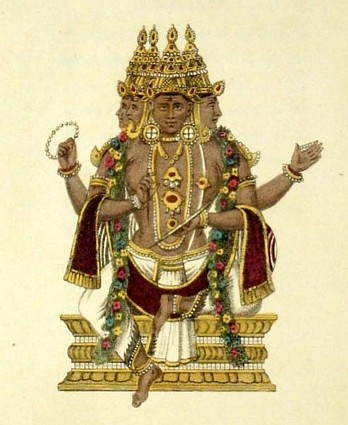A Simple Guide to Help Understand Hindu Gods
Lord Brahma
The Hindu Trinity of Gods
Brahma, Vishnu and Shiva
Hindus have a multitude of gods and goddesses that symbolize the one abstract Supreme Being or Brahman. The most fundamental of Hindu deities are the Trinity of Brahma, Vishnu and Shiva. But many other gods and goddesses such as Ganesha, Krishna, Rama, Hanuman, and Kali.
Lord Brahma
Brahma is the Hindu god of creation and one of the Trinity, the others being Vishnu and Shiva. He is often referred to as the progenitor or the
great grandsire of all human beings. He is not to be confused with the Supreme Cosmic Spirit in Hindu, BRAHMAN.
According to one tradition, Brahma is self-born in the lotus flower which grew from the navel of Vishnu at the beginning of the universe. Brahma is said also to be the son of the Supreme Being, BRAHMAN.
The complexion of Lord Brahma is red. He is clad in red clothes. Brahma is traditionally depicted with four heads, four faces, and four arms. He is
depicted sitting on a lotus flower which symbolizes reality. The four faces of Brahma are said to represent the four sacred texts which he constantly
recites. His heads also represent four ways we perceive that reality, namely: the mind, the intellect, the ego and conditioned-consciousness.
| Unlike most other Hindu Gods, Brahma holds no weapons; each hand holds a sacrificial tool. One of His hands holds a scepter in the form of a spoon, which is associated with the pouring of holy oil onto a sacrificial pyre, signifying Brahma as the lord of sacrifices. Another of His hands holds a jar made of metal or even coconut shell, containing water. The water in this jar signifies the initial, all-encompassing ether in which the first element of creation evolved. Brahma also holds a string of prayer beads which He uses to keep track of the Universe's time. He is also shown holding the Vedas and, sometimes, a lotus flower. |  |
The lifespan of Brahma is 100 Brahma years, equivalent to 311,040,000,000,000 solar years. At the end of His lifespan, there will be a gap of 100 Brahma years, after which another Brahma or creator will begin the process of creation anew. This cycle is thought to repeat without end. Against such immense scale, olne single lifetime becomes insignificant
Although Brahma is one of the three major gods in Hinduism, few Hindus actually worship him. There are very few temples dedicated to Brahma, as opposed to the tens of thousands of temples dedicated to the other deities in the Trinity, Vishnu and Shiva.
A story in connection with Brahma's four heads is that when Brahma was creating the universe, he made a female deity known as Shatarupa with a hundred beautiful forms. Brahma became immediately infatuated. Shatarupa moved in various directions to avoid the gaze of Brahma, but wherever she went, Brahma developed a head. Thus, Brahma developed five heads, one on each side and one above the others. In order to control Brahma, Shiva cut off the top head. Also, Shiva felt that Shatarupa was Brahma's daughter, having been created by him. Therefore, Shiva determined, it was wrong for Brahma to become obsessed with her. He directed that there be no proper worship in India for the "unholy" Brahma.
Another story which describes the curse that supposedly prevented Brahma from being worshiped on Earth is that Brahma and Vishnu were touring the Universe one day and found a pillar of light which extended farther than they could perceive in two directions. They were curious and decided to split up to see if one of them could find an end. Vishnu went in one direction and Brahma the other. After some time, they returned to their starting place. Vishnu said that he was unable to find the beginning, no matter how far he traveled. Brahma said that he found a beginning. He lied. Thereupon, the Pillar of light immediately changed into a form of Shiva who called Brahma a liar and sentenced him to be little observed in the divine ceremonies.
The lesson of the above story is that the ego always wishes to perpetuate itself. And the act of creation (Brahma is the Great Creator) takes ego... even divine ego... to accomplish things. Lord Brahma is invoked to help us surrender the ego and better serve humanity. He can also be invoked for creative inspiration and flashes of new thoughts to discover the secrets of nature.
Wikipedia
Rudraksha-Ratna
Brahma
Brahma
Brahma
Brahma
Brahman
Hundu Gods
Yogalife
About Hinduism
For more information about our travels write to![]() Belli.
Belli.
![]()